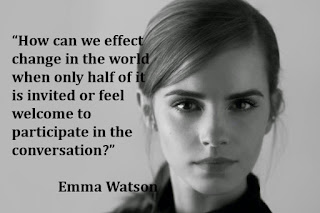Feminist Conscience
Within this blog, I talk a lot
about Betty Friedan, a feminist author and member of NOW, The National Organization
for Women, because her ideas in her book, “The Feminine Mystique”, pertains to
the articles we read and to Second Wave Feminism.
When reading the title of Echols
article, “The Re-Emergence of the “Woman Question”, I was reminded of a concept
I read in Betty Friedan’s book, “The Feminine Mystique”. I recalled Friedan
saying that with the Civils Rights movement and other activist movements, a
feminine conscience was spurred, thus leading to the Second Wave. I think it is
important to acknowledge that this conscientiousness was not new, but perhaps
something that had been hushed and put aside. With the emergence of the Civil
Rights movement, however, women were more conscientious of the inequalities
they faced and felt more comfortable to speak out. This act of speaking out and
participation was in large part motivated by previous movements. Just as the
Civil Rights movement and the First Wave movement spurred off of the
abolitionist movement, so too did the Second Wave movement progress from Civil
Rights activist organizations, such as: the “Student Nonviolent Coordinating
Committee” and “Students for a Democratic Society” as mentioned in Echols
article. While these activist movements helped ignite the beginning of the
Second Wave movement, Echols describes the relationship between the movements
as “complicated and paradoxical” because these movements were mostly “dominated
by men, who were, at best, uninterested in challenging sexual inequality. Yet,
although sexism was still prevalent in these Civil Rights groups, women were
instilled with the desire to want more and the confidence to break free from
their pre-assigned domestic spheres, leading back to the idea of the feminist
conscience. Another quote from Friedan’s book, “Feminine Mystique”, that I think
is relevant to the feelings of women during this time is the question that “Each
suburban wife struggles with as she made the beds and shopped for groceries…Is
this all?.” This questioning of identity is what I think as perhaps the most
important pieces during the Second Wave movement. Although I said most women,
what I really mean is middle to upper class white women, who unlike black,
other minorities, and poor women, have the privilege of being able to question
these feelings. In a sense, being able to have this desire to break free from
the domestic sphere is a luxury that most women are not afforded. It is
important to recognize that the Second Wave Feminist Movement, although all-encompassing,
mostly pertained to a specific group of women, that being white, upper/middle
class women.
Ti-Grace Atkinson, a member of NOW
and a Radical Feminist Author, proclaims in her article, “Radical Feminism”,
that in short, men are the enemy. Reading this statement in the first paragraph
was unsettling because as a feminist, I believe that we are no better than the
oppressors if we become one ourselves and subjugate others to the same
oppression and discrimination. Thus, I would agree with Friedan’s statement
that, “Men are not the enemy, but fellow victims. The real enemy is women’s
denigration of themselves”. Although I disagree with Atkinson’s statement that
men are the enemies, I thought it was interesting how in her article she
mentions the biological characteristics of men because I think in that sense it
ties this reading quite easily with our others readings in the sense that these
stereotypes and categorizations are methods which have the ability to
dehumanize and devalue people as a whole.
- Jane B




Comments
Post a Comment